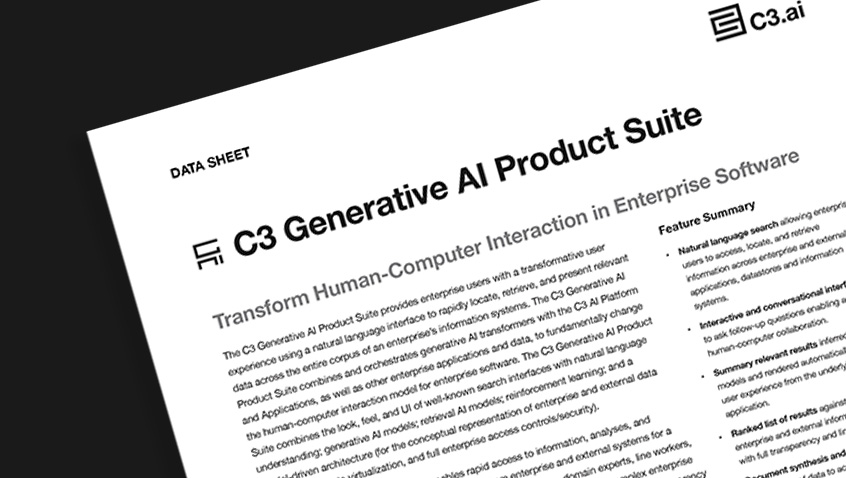- AI Software
- C3 AI Applications
- C3 AI Applications Overview
- C3 AI Anti-Money Laundering
- C3 AI Cash Management
- C3 AI Contested Logistics
- C3 AI CRM
- C3 AI Decision Advantage
- C3 AI Demand Forecasting
- C3 AI Energy Management
- C3 AI ESG
- C3 AI Health
- C3 AI Intelligence Analysis
- C3 AI Inventory Optimization
- C3 AI Process Optimization
- C3 AI Production Schedule Optimization
- C3 AI Property Appraisal
- C3 AI Readiness
- C3 AI Reliability
- C3 AI Smart Lending
- C3 AI Supply Network Risk
- C3 AI Turnaround Optimization
- C3 Generative AI Constituent Services
- C3 Law Enforcement
- C3 Agentic AI Platform
- C3 Generative AI
- Get Started with a C3 AI Pilot
- Industries
- Customers
- Events
- Resources
- Generative AI for Business
- Generative AI for Business
- C3 Generative AI: How Is It Unique?
- Reimagining the Enterprise with AI
- What To Consider When Using Generative AI
- Why Generative AI Is ‘Like the Internet Circa 1996’
- Can the Generative AI Hallucination Problem be Overcome?
- Transforming Healthcare Operations with Generative AI
- Data Avalanche to Strategic Advantage: Generative AI in Supply Chains
- Supply Chains for a Dangerous World: ‘Flexible, Resilient, Powered by AI’
- LLMs Pose Major Security Risks, Serving As ‘Attack Vectors’
- What Is Enterprise AI?
- Machine Learning
- Introduction
- What is Machine Learning?
- Tuning a Machine Learning Model
- Evaluating Model Performance
- Runtimes and Compute Requirements
- Selecting the Right AI/ML Problems
- Best Practices in Prototyping
- Best Practices in Ongoing Operations
- Building a Strong Team
- About the Author
- References
- Download eBook
- All Resources
- Publications
- Customer Viewpoints
- Blog
- Glossary
- Developer Portal
- Generative AI for Business
- News
- Company
- Contact Us
- Generative AI for Business
- Reimagining the Enterprise with AI
- What To Consider When Using Generative AI
- Why Generative AI Is ‘Like the Internet Circa 1996’
- Can the Generative AI Hallucination Problem be Overcome?
- Transforming Healthcare Operations with Generative AI
- Data Avalanche to Strategic Advantage: Generative AI in Supply Chains
- Supply Chains for a Dangerous World: ‘Flexible, Resilient, Powered by AI’
- LLMs Pose Major Security Risks, Serving As ‘Attack Vectors’
- C3 Generative AI: Getting the Most Out of Enterprise Data
- The Key to Generative AI Adoption: ‘Trusted, Reliable, Safe Answers’
- Generative AI in Healthcare: The Opportunity for Medical Device Manufacturers
- Generative AI in Healthcare: The End of Administrative Burdens for Workers
- Generative AI for the Department of Defense: The Power of Instant Insights
- C3 AI’s Generative AI Journey
- What Makes C3 Generative AI Unique
- How C3 Generative AI Is Transforming Businesses
Reimagining the Enterprise with AI
by Jim Snabe, Chairman Siemens and former co-CEO, SAP
Introduction
Clayton Christensen’s celebrated book, The Innovator’s Dilemma, describes how large, established enterprises struggle in adopting disruptive technologies. The oft-proven premise is that as companies grow, scale, and optimize existing products they must face a dilemma to either continue down the same beaten path of incremental improvements delivering steady returns, inexorably leading to a declining market position, or reinvent by preemptively replacing their existing product(s) with disruptive technologies. Netflix is a good example of a company that successfully resolved their Innovator’s Dilemma by transitioning entirely to a streaming service, while Kodak is an example of one that did not.
Most companies today are facing a similar dilemma as they grapple with the adoption of AI. Those who ignore it risk falling behind their peers as they rely on increasingly outdated and backward-looking systems, leaving them reacting to market disruptions. Those that adopt enterprise AI and its new companion, generative AI, can enable anticipatory decision-making for every employee from the frontline to the boardroom, driving responsiveness, efficiency, and agility across the business. The pace and alacrity with which companies adopt AI will determine their long-term competitiveness and survival.

Decision-Making Today: A Rear-Gazing High-Speed Chase
Today, leaders in most companies use data and metrics to assess performance, identify gaps, make course-correction decisions, and update plans. These could be financial metrics such as profit per customer or supply chain metrics such as On-Time-In-Full. In most companies, these metrics are assembled from data provided by enterprise applications such as ERP, CRM, SCM, and HRM.
This data is usually current for the most recent planning period. The more progressive companies may have data that is more current or even near real-time. But in almost all companies, this is historical data about what has already happened, the figurative equivalent of driving forward with your eyes fixed on the rearview mirror.
Leaders can get away with making decisions based on historical data when the world is stable, business conditions are certain, and the road ahead is straight, flat, and deserted. But today’s tumultuous post-pandemic world riven with macroeconomic, geopolitical, and technology disruptions, is anything but stable and certain.
What leaders and decision makers need today is not only data about the past, but reliable predictions about the future that they can trust and reference. Leaders today need the predictive capabilities of AI that can help them anticipate and shape the future.




